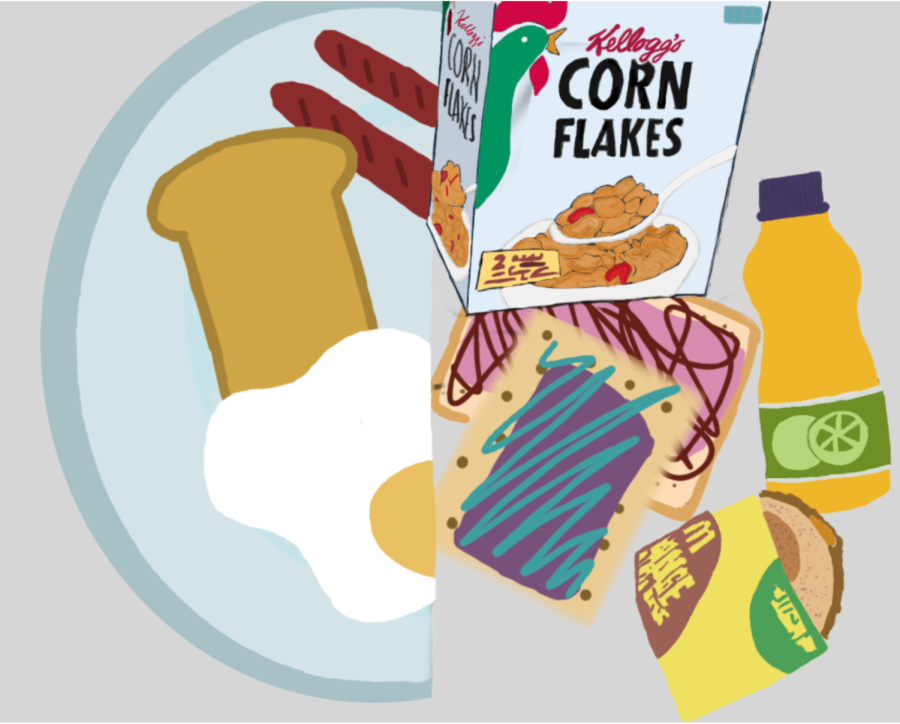The rise of breakfast
Graphic Illustration by Audrey Wong
From a sit down home cooked meal to convenient packaged pastries, breakfast items evolve to fit our lifestyle.
May 27, 2021
With the plethora of sugary, carbohydrate-packed, grab-and-go breakfast choices that claim to be “healthy,” sit-down meals with family seem to be vestiges of the past.
During the Middle Ages, Europeans considered eating breakfast as committing one of the seven deadly sins: gluttony. Fasting was seen as the ability to not give in to temptations and desires. They often ate a light meal at midday and a heavier dinner in the evening, followed by a late night snack session called “reresoper.” There were some exceptions, such as laborers, who needed more energy, as well as the elderly and children. However, this small meal acted as a tie-over, with individuals consuming only small pieces of bread, rather than treating it as a social event since it was consumed faster. In 1558, Thomas Cogan, a schoolmaster in Manchester, promoted the idea that it was essential to an individual’s health to eat breakfast, and thus, the standard became to eat breakfast.
In the 1810s, breakfast for the wealthy in Europe consisted of leftovers from the night before; the wealthy often ate it cold so that they did not have to heat up food using a fire. Some other delicacies included Corn Pops, stale popcorn and milk, along with fruit pies.
By the 1800s, the farmer’s breakfast started showing up on the table in the U.S. Eggs have always been a popular breakfast item due to its accessibility, and cured meat from slaughtered pigs also made its way to the table as bacon.
The Industrial Revolution in the 19th century normalized eating breakfast. As laborers often packed lunches rather than eating at home, breakfast was seen as a family event. Additionally, because laborers worked in factories, they needed to eat before going to work to have enough energy. This also led to more breakfast choices to provide a heartier meal for workers.
In the 1920s, public relations pioneer Edward Bernays persuaded doctors to advertise the benefits of bacon and eggs as a healthy breakfast option to increase bacon sales. With 5,000 doctors convinced and the information published in the newspaper, bacon and eggs became a staple breakfast combination.
Similarly, orange juice as a morning beverage was marketed as beneficial to one’s health rather than associated with the breakfast meal itself. Orange juice was originally not as readily available as it is now since oranges were highly perishable and only available for those who lived near an orange farm. In the 20th century, juice pasteurization allowed canned juices to be sold to more consumers. Orange juice’s popularity spiked during the worldwide influenza outbreak as people became more conscious about vitamins.
Due to the growing emphasis on well-being, certain food items became popular as they were marketed as health foods. In 1963, James Caleb Jackson created the first cold cereal, called Granula. During this time, dyspepsia — indigestion — was common, and it was believed that a high-fat and protein diet was the reason for this condition. John Harvey Kellogg, a doctor and medical superintendent at the Western Health Reform Institute and Adventist, believed that consuming too much meat and spices had negative effects, preferring grains. Kellogg also believed that eating grains would reduce the desire for sex and masturbating. In the 1890s, Kellogg discovered that, if he overcooked wheat and dried it, the grains became flakes, thus inventing cornflakes. The success of cereal can be attributed to sugar and advertising techniques. By the 1940s, Post Cereal and Kellog’s had covered their cereal with sugar, paving the way for the innovation of modern cereals.
Despite the added sugar, advertising maintained the concept of cereal as a health food. The ads appealed to the American population by reinforcing its healthy benefits and taking advantage of the health concerns during that time. Cereal companies claimed that it provided carbohydrate and fiber for a healthy diet. The slogan “Breakfast is the most important meal of the day” was created by Kellogs for the purpose of selling corn flakes cereal. To appeal to children, mascots, such as Tony the Tiger for Frosted Flakes and Snap, Crackle and Pop for Rice Krispies were created. This marketing method continues today.
The growing popularity of cereal created a model of ready-to-eat breakfast items. With more women entering the workforce and not having time to cook breakfast, cereal and other quick breakfast items replaced the sit-down meal.
In the 1960s, Pop-Tarts and other packaged items contributed to the “nobody has time for that” breakfast narrative. As more than one third of the workforce was made up of women and feminist beliefs became more widespread, the view of women’s belonging in the kitchen had shifted. Furthermore, maternal guilt was used to market these products, as mothers had less time to prepare meals for their children. This resulted in a shift in focus from home cooking to convenience products. The idea that children could prepare their own meals also contributed to the rise in popularity of packaged products.
In the 1970s, breakfast was introduced to quick-service restaurants, which paved the way for current fast food breakfasts. McDonald’s was the first franchise to include breakfast as part of its menu, and, shortly after, other popular fast food restaurants such as Burger King and Taco Bell followed.
“Breakfast has evolved through the decades as the dietary recommendations have evolved through the decades,” said Megan Miller, culinary arts and food science teacher. “The USDA publishes recommended guidelines for Americans to reference as a way to maintain health. As these guidelines change through the years and through the decades, so does the eating pattern of many Americans. Of course, cultural connections play a huge role in what individuals choose to consume (or skip) as their breakfast choices.”
Despite the growing popularity of breakfast and its evolving forms, the debate over the necessity of consuming breakfast and its effects on the human body still remains. Research done by Mark Mattson, a neuroscientist at the National Institute of Aging and at the John Hopkins University School of Medicine, suggests that skipping breakfast and following an intermittent fasting schedule in which one eats only within an eight-hour window each day assists with weight-loss. Mattson recommends people begin eating at noon and stop at 8 p.m. Once the body has adapted to skipping breakfast, it will not get the negative side effects. Other studies have shown that loading up on calories during breakfast time while having a small lunch and dinner can help with weight loss and reduce the risk of diabetes and cardiovascular disease. Despite the reasons for breakfast being beneficial to the human body, eating a sugar-loaded meal is definitely not healthy. A calorie-loaded, nutritious breakfast should include protein, whole grains, healthy fats, a fruit or vegetable, and a food or beverage that is high in calcium.
“Just grabbing something and calling it breakfast isn’t necessarily beneficial to your body, but being thoughtful about what you’re [eating] can have a huge benefit on being more alert during the day and helping keep your body healthy,” said Kristi Kuehn, culinary arts teacher at Cupertino High School.
As the debate between fasting or breaking the fast continues, breakfast food items have simultaneously evolved.
“From my personal experience, I used to not have breakfast at all because I used to sleep in,” Lynbrook alumna Valerie Kan said. “But now, as I started working for my internship, I actually feel like breakfast is really important because skipping any one of the meals would make my performance not as good. I am not energized which makes me actually think breakfast does have an impact. When you have something, you start your metabolism and your body is actually functioning.”





























































